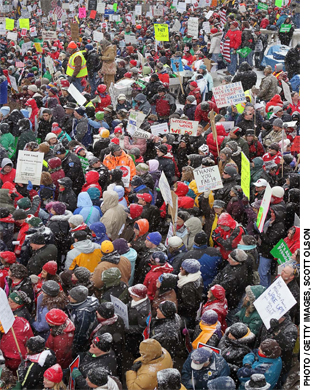Complete survey results available here.
Education Next readers took this survey as well. See how their responses compared.
Public education has rarely been far from the national headlines over the past year. Efforts to limit teachers’ collective-bargaining rights led to mass protests in several states. The enactment of voucher programs renewed the debate over the role of private school choice in American education. Meanwhile, the first significant budget cuts in recent memory forced public school districts to tighten their belts in unprecedented ways. The Obama administration has encouraged a nationwide effort to develop common school standards. And let’s not forget Waiting for “Superman,” the high-profile documentary whose poignant portrayal of the charter-school admissions process, coupled with a critique of union power in public schools, was expected to have a significant impact on national opinion.
But how have Americans actually responded to these developments? Have they grown more supportive of the current direction of school reform, or are there instead signs of a backlash? And how do the views of teachers compare to those of the public at large?
These are among the questions we explore in this, the fifth-annual Education Next–PEPG Survey, which interviewed a nationally representative sample of some 2,600 American citizens during April and May of 2011 (see sidebar for survey methodology). In addition to the views of the public as a whole, we pay special attention in this year’s survey to two potentially influential types of participants in school politics: the affluent and teachers. To our knowledge, this is the first survey of a nationally representative sample of affluent Americans, defined as college graduates who are in the top income decile in their state. This is the third year we have surveyed a nationally representative sample of teachers, defined as full-time teachers currently working in public schools. Both the affluent and teachers pay more attention to public education and participate more actively in school politics than the general public, making their views worthy of close scrutiny (see sidebar).
Teachers and the Affluent: Paying Attention, Participating, and Holding Opinions
A highly decentralized, democratic system of education affords all sorts of opportunities for average citizens to weigh in on public schools. Through votes, school board meetings, petition drives, and direct advocacy, all citizens, at least in principle, can influence public education.
Principle and practice, however, often part ways. That all citizens can influence public education is not to say that all citizens do so. Generations of political science research confirm that higher-income and, especially, better-educated citizens are orders of magnitude more likely to participate in politics. And recent evidence demonstrates that teachers are far more likely to vote in school board elections than is the general public.
In our own survey, 37 percent of the American public claims to pay either “a great deal” or “quite a bit” of attention to issues involving education, while 54 percent of the affluent and an overwhelming 84 percent of teachers do so.
Public opinion surveys routinely overstate the levels of turnout in elections. Hence, it is difficult to know what to make of the absolute numbers of any particular group that reports voting. By comparing across groups, though, we can generate reasonable estimates of the relative tendency of people to vote. When we do, we find further evidence of the high rates of political participation among both the affluent and teachers. Compared to the American public at large, members of the affluent group are 16 percentage points more likely to report having voted. Teachers are fully 18 percentage points more likely to report having done so.
These two groups also are more likely to pronounce a clear view about the quality of schools and the value of different education reforms. The percentage that selects the “don’t know” or “neither support nor oppose” categories is almost always larger for the general public than for either the affluent or teachers.
Our findings reveal more stability than change in public opinion over the five years since the Education Next–PEPG survey began, suggesting that the momentous policy developments of the past year were not caused by—nor have they yet produced—broad changes in popular views. The one exception to that generalization is a significant turnaround in support for school vouchers, which until this year had been in decline.
The views of the affluent resemble those of the general public, except that the affluent are more likely to hold strong opinions and even larger percentages support the positions taken by a plurality of the general public. However, the well-to-do are more skeptical of online learning. They also hold the public schools in their own community in comparatively high regard, perhaps because they have better access to good public schools.
Teacher opinion often diverges from that of both the affluent and the general public. Teachers are much more likely to give schools high marks; on many issues, a majority of teachers takes the side opposite to that of the larger public, revealing tensions between what Americans overall think is best and what employees within the education industry prefer.
Teacher Rights and Policies
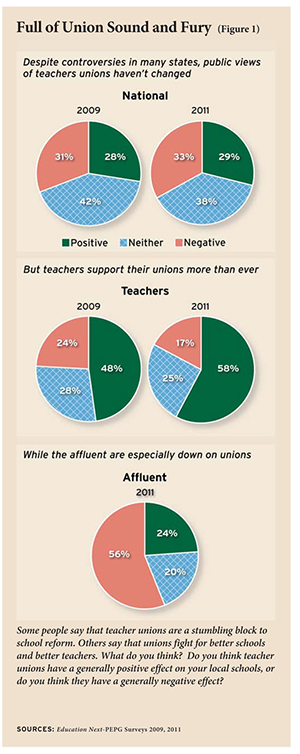
Wisconsin’s curtailment of the collective bargaining rights of teachers and other public employees was undoubtedly the top education news story of early 2011. In protest, teachers called in sick in droves, union members crowded the state capitol, and Democratic senators refused to attend legislative sessions. President Obama supported the protests, while Republican leaders lent their support to the embattled Wisconsin governor. Similar issues involving union rights and teacher prerogatives percolated in other states as well, including Indiana, Tennessee, Ohio, and even Massachusetts.
What was the public response? Are the opinions of teachers and the public converging or diverging? The short answer: Public opinion on issues involving teacher rights and prerogatives has remained essentially unchanged, but teachers’ opinions are diverging on key issues.
Teachers Unions. When asked whether teachers unions have a generally positive or negative effect on the nation’s public schools, 33 percent of the public gives a negative response, virtually unchanged from the 31 percent and 33 percent who perceived a negative impact in 2009 and 2010, respectively (see Figure 1). The share perceiving a positive union impact on schools hardly budged, changing only from 28 percent in 2009 to 29 percent in 2011. A sizable plurality of 38 percent continues to hold a neutral position, suggesting that the debate over the role of teachers unions is hardly over. The views about teachers unions held by the affluent are more negative, with no less than 56 percent saying unions have a negative impact on their schools.
Among teachers themselves, opinion is moving in precisely the opposite direction from that of the public at large. Only 17 percent now say that unions have a negative impact on the nation’s schools, down from 25 percent in 2010. Fifty-eight percent think they have a positive impact, up from 51 percent the previous year.
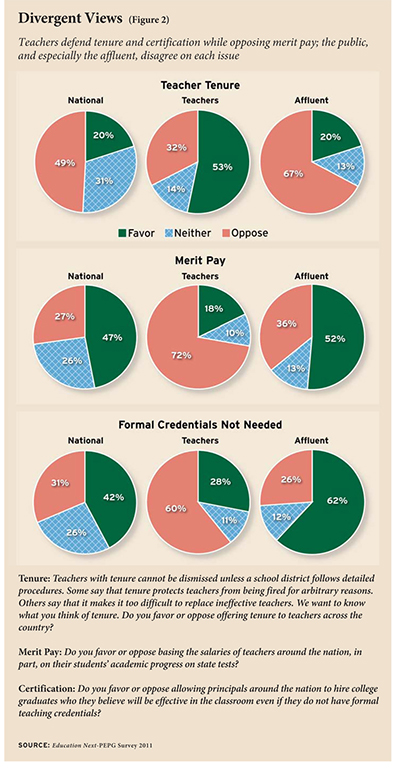
Teacher Tenure. Opposition to teacher tenure edged upward, but not to a significant degree. Between 2009 and 2010, those opposed to tenure shifted slightly from 45 percent to 47 percent, and in 2011 that percentage again ticked upward to 49 percent. Moreover, tenure supporters slipped from 25 percent in prior years to 20 percent in 2011. Unless the trend continues in future years, not much should be made of these small shifts. Among the affluent, opposition to tenure was much greater—no less than 67 percent. Meanwhile, teachers like tenure more than ever. Fifty-three percent now say they support tenure, up from 48 percent a year ago.
If tenure is to be given at all, the public thinks it should be based on demonstrated success in raising student performance on state tests. Those who say tenure should be based on student academic progress increased from 49 percent to 55 percent between 2010 and 2011. The well-to-do also like the idea, with 61 percent giving it their support. Teachers, however, were far less enthusiastic about the idea, only 30 percent giving it a favorable nod.
Merit Pay. The issue of merit pay made national news in 2010 when then Florida governor Charlie Crist vetoed a controversial bill requiring that teachers statewide be paid based on their classroom performance. Although Crist’s veto brought him favor with the state’s teachers unions, his successor signed similar legislation in 2011. Meanwhile, states and districts around the nation continue to experiment with new models of teacher compensation.
The public tends to favor merit pay, and recent developments have not altered that fact in one direction or another. A near majority (47 percent) of the American public favors paying teachers, in part, based on the academic progress of their students on state tests, about the same percentage as in 2007. Only 27 percent of the public opposes the idea, with the balance undecided. Affluent respondents were only modestly more likely (52 percent) to favor merit pay. The idea remains anathema to teachers, however, with only 18 percent in favor, and 72 percent opposed (see Figure 2). Despite the Obama administration’s continued efforts to build support for merit pay among teachers, the vast majority remains unconvinced.
Teacher Compensation. If teachers and the public disagree on many things, the public nonetheless wants to pay teachers well. Fifty-five percent of the public thinks salaries should increase, virtually the same percentage that voiced that opinion two years ago. Support for higher teacher salaries among the affluent is slightly higher (59 percent). Those who do not favor increases think salaries should remain at current levels. Only 7 percent of the public as a whole thinks teacher salaries should be cut. Needless to say, salary increases for teachers is hardly an issue among teachers themselves. Eighty-two percent of them give the proposal their wholehearted support (see Figure 3).
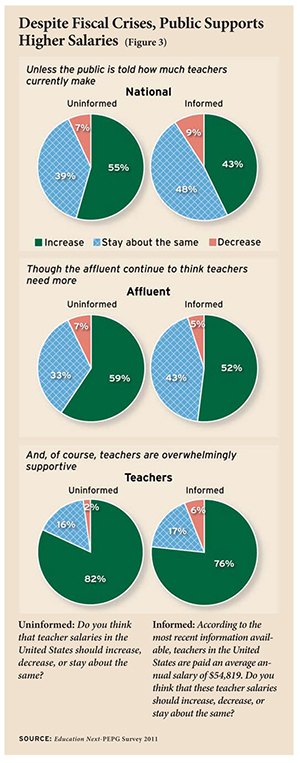
Support drops, however, when those surveyed are told how much the average teacher in their state is currently paid. It falls to 43 percent, although a majority (52 percent) of the well-to-do still favors a salary increase. Learning the actual salary levels had little impact on the thinking of teachers themselves, over three-quarters (76 percent) of whom continue to back the idea.
When Americans are asked to choose between increasing teacher salaries and reducing class sizes, they regularly select the latter option. Even when they are told that “reducing average class sizes by three students would cost roughly the same amount as increasing teacher salaries by $10,000,” 44 percent of Americans select class-size reduction, whereas 28 percent select increasing teacher salaries. The affluent have similar views. By contrast, roughly equal numbers of teachers would choose salary increases as would choose class-size reduction.
Of course, teacher remuneration goes well beyond salaries. On average, teachers enjoy considerably larger pension benefits and health-care packages than do comparable professionals in the private sector, a point of contention in recent policy debates. In April 2011, for example, Ohio enacted legislation requiring all public employees, including teachers, to contribute at least 15 percent of the cost of their health-care benefits. Yet the battle over the issue is far from over: The Ohio Education Association recently collected a one-time assessment of $54 from each of the state’s teachers, raising $5 million to advocate for the law’s repeal.
It is of interest, then, that the American public tends to look favorably on a proposal that would require teachers “to pay from their salaries 20 percent of the cost of their health care and pension benefits, with the government covering the remainder.” By a nearly two-to-one margin, the American public favors this policy. The margin of support is even larger among the affluent, a majority of whom back this requirement. Teachers overwhelmingly reject this cost-cutting measure, with opponents outnumbering supporters more than two to one.
Teacher Certification. In most states, teachers must take approximately 30 hours of instruction at a school of education before they may be certified as a teacher. A substantial body of research demonstrates that such instruction does not translate into higher student performance. And the American public seems to have caught on. A plurality of Americans supports (42 percent, while 31 percent oppose) allowing principals to “hire college graduates who they believe will be effective in the classroom even if they do not have formal teaching credentials.” As for the affluent, no less than 61 percent support the relaxation of teacher hiring requirements. Existing teachers, by contrast, steadfastly oppose the practice, perhaps because virtually all of them underwent the formal credentialing process. Fully 60 percent of teachers object to the idea of principals being allowed to hire college graduates who do not have formal teaching credentials, and only 28 percent support it.
All in all, the Wisconsin controversy seems to have contributed to a divergence of opinion between teachers and the general public. The biggest changes in opinion took place within the teaching profession, which moved further away from the views of the public at large. The public, and especially the affluent, nonetheless want to pay teachers more.
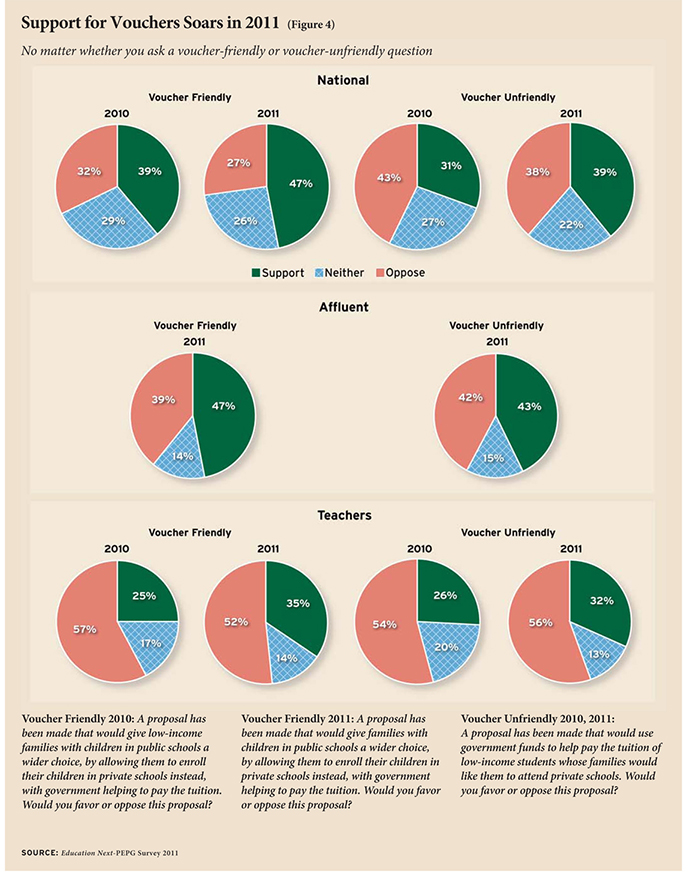
School Choice
A strong case can be made that 2010 and 2011 were among the very best years school choice has yet enjoyed. The number of students in charter schools grew to 1.7 million, and several states raised caps on the number of charter schools that will be permitted to open in the future. Indiana, Ohio, Florida, Arizona, and New Mexico all passed voucher legislation of one kind or another, and Congress restored the federal school-voucher program it had previously shut down in Washington, D.C. What has been the public’s response?
Vouchers. Opinion on vouchers varies, depending on how the question is posed. We therefore randomly assigned respondents to two groups, one of which was asked a question that might be termed “voucher-friendly” in that it emphasizes giving a choice to parents. The other half was asked a question that might be termed “voucher-unfriendly” in that it emphasizes students going to private school at public expense. Not surprisingly, members of the public are more likely to say they like vouchers (47 percent) if asked the first question than if asked the second (39 percent). (See Figure 4 for the wording of the questions and the pattern of responses to each.)
There is little scientific basis for deciding which of these questions is the “right” one to ask. Instead of focusing on the number obtained by either question, therefore, it often is more informative to look at differences between groups and changes that take place over time.
Viewed in these ways, three facts stand out. First, support for vouchers increased by 8 percentage points between 2010 and 2011. This was the largest shift of public opinion over the course of the past year. If the public debate altered anything, it was regarding this specific topic. That the change in opinion is registered by responses to both questions leads one to conclude that the survey identified a genuine political development. Second, the affluent express more opposition to vouchers than the general public. The level of opposition is 12 percentage points higher in response to one version of the question and 4 percentage points higher on the other. Third, teachers are the least enthusiastic about vouchers. Although their opinions, like those of the general public, shifted in a favorable direction in 2011, teachers are still as much as 25 percentage points more opposed to vouchers than is the public as a whole.
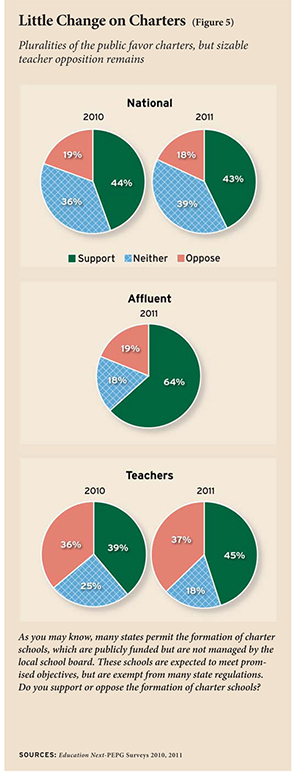
Tax Credits. Public opinion on other school-choice issues remains stable. When it comes to tax credits for education expenses for families attending either public or private schools, a majority is in favor, and opposition is less than 20 percent. Almost the same can be said for the more common approach of offering tax credits for individual or corporate donations to scholarship programs. On both items, though, little change is detected from previous years. Nor do either the affluent or teachers think much differently.
Charter Schools. When asked about charters, 43 percent of the American public comes out in support, hardly different from the percentage that did so in 2010 (see Figure 5). The most common response, though, continues to be “neither support nor oppose.” When one segment of respondents was asked to choose between “support,” “oppose,” and “don’t know,” a similar proportion selected ”don’t know” as had selected “neither support nor oppose,” again suggesting that Americans either do not understand what charter schools are or have not made up their minds about them (see “Educating the Public,” features, Summer 2009). These findings are all the more remarkable given that charter schools are now two decades in the making, and in just the last year they have received substantial media attention, been the subject of a major documentary, and enjoyed the endorsement of leaders of both political parties, including key members of the Obama administration.
The affluent are especially likely to favor charter schools, with 64 percent offering their endorsement. Interestingly, the biggest jump in support for charters seems to have taken place among teachers. Those favoring the idea increased from 39 percent to 45 percent over the past year, while opposition remained unchanged.
Single-Sex Schools. Once pervasive in American education, gender-specific public schools were until quite recently a vanishing species. The notion of educating boys and girls separately, however, received a boost in 2006 with the publication of new federal regulations clarifying the legal status of single-sex schools and classrooms. The National Association for Single Sex Public Education reports that 524 public schools now offer students opportunities for single-sex education, including 103 in which students have all of their educational activities in a gender-specific setting.
Thirty-four percent of Americans support proposals that would give “parents the option of sending their child to an all-boys or all-girls school,” while only 23 percent are opposed. Opinion has not changed since the same question was last posed back in 2009. Interestingly, the well-to-do are even more favorably disposed to the idea, with no less than 47 percent giving it their support. Teachers, too, like the idea. Given the widespread support for providing families a single-sex option, it is surprising no politician has made this issue an election platform component.
Grading Public Schools
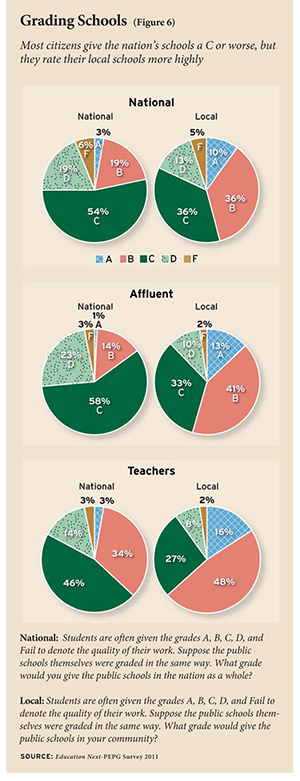
Last year we reported that the public’s evaluations of the nation’s public schools had reached an all-time low. Only 18 percent of the public was willing to give the schools an A or a B, while 27 percent said they deserved no better than a D or an F. Those evaluations were decidedly lower than the grades given by those asked by the Phi Delta Kappa/Gallup poll earlier in the decade, and even lower than the percentage reported by Education Next in 2007 (when only 22 percent gave their schools top marks).
Happily, in 2011, evaluations of public schools have ticked upward ever so modestly, with 22 percent again willing to give their schools an A or B, though 25 percent of those evaluations are still handing out either a D or F. The affluent are by far the toughest graders, with only 15 percent of them giving the nation’s schools the highest marks. Teachers, by contrast, are much more generous in their evaluations, with 37 percent saying that the nation’s schools deserve an A or B (see Figure 6).
The portrait of public satisfaction changes dramatically, however, if one inquires about Americans’ local public schools. No less than 46 percent of those surveyed give their community schools an A or a B, a slightly higher percentage than in 2007 (43 percent). The affluent, as critical as they are of the nation’s schools, are more content with their local schools than the public at large: 54 percent say their local schools deserve one of the two high grades. Teachers especially like their own community’s schools, with 64 percent of them giving out an A or a B.
Spending on Public Schools
For the United States economy, the past three years have been hard times: The country has yet to recover fully from the recession that began in 2008. Unemployment hovers around 9 percent, salary increases are hard to come by, and public treasuries are steeped in debt. The stimulus package of 2009 provided a short-term revenue fix for school districts, but those dollars, at best, barely offset sharp declines from local tax revenues. In the spring of 2011, when this survey was administered, no one thought it would be easy for school districts to balance their budgets. Under the circumstances, it would not be surprising if the public concluded that cutbacks in school expenditures were appropriate.
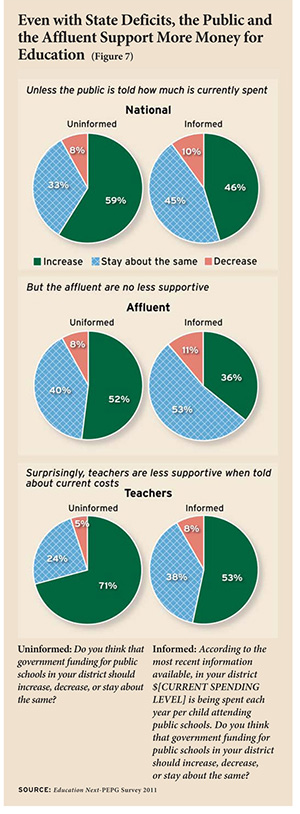
Not so. When the public was asked whether government funding for public schools in their district should increase, decrease, or stay the same, 59 percent selected the first option, only slightly less than the 63 percent that gave that opinion in 2010, and dramatically more than in 2009 (46 percent). Affluent respondents were less willing to spend more for their district schools, but even among them a clear majority (52 percent) preferred an increase in expenditures.
A segment of those surveyed were asked the same question except that they were first told the level of per-pupil expenditure in their community, which averaged $12,300 for the respondents in our sample. For every subgroup considered, this single piece of information dampened public enthusiasm for increased spending. Support for more spending fell from 59 percent to 46 percent of those surveyed. Among the well-to-do, the level of support dropped dramatically, from 52 percent to 36 percent. Among teachers, support for expenditure increases fell even more sharply—from 71 percent to 53 percent (see Figure 7).
When asked about the possibility of raising taxes to fund public schools, support for greater spending dropped further still. Only 28 percent of Americans believe that local taxes to support public schools should be increased, while over half believe that they should stay the same, and 16 percent believe that they should decrease. The views of the affluent do not differ notably from the public as a whole and even among teachers only 42 percent support higher taxes.
Digital Learning
Online education has become a growth industry, as a rapidly increasing number of high school and college students are taking some of their courses over the Internet. Some, including Harvard Business School professor Clayton Christiansen, have gone so far as to predict that half of all high school courses will be taken online within a decade.
A year ago such projections seemed plausible, as public support for learning over the Internet jumped 10 points, to a total 52 percent, from where it had been the previous year. But if online learning is going to sweep the country, that percentage needs to continue to climb, and in 2011, support slipped modestly to 47 percent. Twenty-six percent of Americans now say they are opposed, up 3 percentage points over 2010 (see Figure 8).
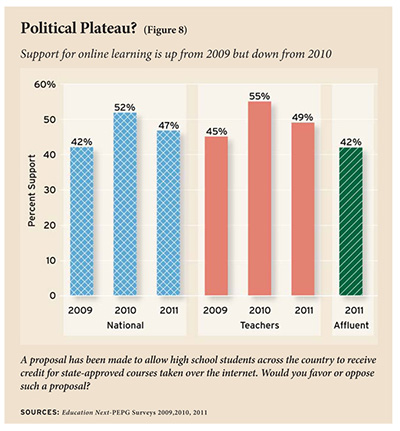
Contrary to the standard image of the educated well-to-do as the first to adopt new technologies, the affluent were somewhat less supportive of the idea than the public as a whole. In fact, the affluent were evenly divided, with opposition as high as 43 percent. Nearly half (49 percent) of teachers also expressed approval, although that percentage was down by 6 percent from 2010.
In short, there are signs that support for online learning is reaching a political plateau, and important segments of the population—teachers and the affluent—are resistant to the idea. Yet, when respondents were asked about their own children, high levels of support for online education are observed across the American public. A majority of Americans overall, and roughly two in three teachers, expresses a willingness to have one of their children take “some academic courses” in high school over the Internet.
School and Student Accountability
Nine years after the enactment of No Child Left Behind, the public’s appetite for standardized tests appears undiminished. More than two in three Americans believe that the federal government should “continue to require that all students be tested in math and reading each year in grades 3–8 and once in high school,” whereas less than 10 percent actually oppose this requirement. Roughly three in four affluent respondents support the regular administration of tests, as do similar shares of African Americans and Hispanics. Only among teachers does there appear a nontrivial segment of the population that opposes existing testing practices. Even so, majorities of teachers support annual testing of lower-school students and a single test for high school students.
Breaking from existing law, however, Americans support the creation of a single national test in both reading and math. Under No Child Left Behind, each state develops its own test and benchmarks for determining student proficiency. Solid pluralities of both the general public and all subgroups, however, believe that there should be one test and one standard for all students across the country. Roughly one in five, by contrast, supports different tests and standards in different states. A paltry number of respondents think that all state and federal tests should be abolished.
Just as Americans support tying teacher pay to student performance on standardized tests, so too do they want students’ eligibility to be promoted from one grade to the next and to graduate from high school to depend on demonstrated success on tests. Fully 70 percent of Americans support a requirement that students pass an exam before being eligible to move on to the next grade. Another 72 percent support a requirement that students pass an exam before being allowed to receive a high school diploma. Support for student accountability, moreover, runs deep across all the subgroups we analyze, including teachers. Sixty percent of teachers support the idea of tying grade promotion to test performance, while 66 percent support high school graduation exams, even as these same teachers overwhelming oppose the idea of linking their own remuneration to student test scores.
That Americans want students to be tested, however, does not mean that they are convinced that current testing provides accurate information about school quality. Indeed, only 7 percent of Americans claim that their state’s standardized test provides “excellent” information about the schools in their state, and only 34 percent claim that it provides “good” information. Forty-seven percent, however, believe that the test provides either “fair” or “poor” information. With just one exception, all of the subgroups follow national trends on this question. As their responses to other questions about testing might indicate, teachers hold standardized tests in the lowest regard. Only one in four teachers claims that the state’s standardized tests offer excellent or good information about the quality of schools, compared to the 69 percent who believe that the information is either fair or poor.
Conflicts with Teachers Likely to Persist
We have discussed only a few highlights from this year’s survey. The reader can glean much more information by taking a careful look at the survey questions and responses, available on the Education Next web site. Here we draw only three broad conclusions:
On many questions of education policy, opinion has not changed materially over the past year, despite the headline news coming from Wisconsin and elsewhere. We are not the first to have documented stability in the policy positions taken by members of the American public. Only when external events require a rethinking of their position are they inclined to alter their views. For that reason, we find it to be of some significance that over the course of the past year the public has become much more supportive of school vouchers.
On most questions of public policy, differences between the affluent and the public at large are on the margins. In no case did we find the well-to-do favoring a policy that the general public opposed. Instead, those with ample resources tend to be even more supportive of the positions that were taken by a plurality of the public. Our data do not allow us to discern whether the affluent are leading or following public opinion more generally, but the findings do suggest a general synchronization of viewpoints. Still, it is the case the affluent are more skeptical of online learning and more satisfied with their local schools than is the general public.
Finally, we find that a majority of teachers often takes positions contrary to those of a plurality of both the public and the affluent on key issues such as teachers unions, the rights and prerogatives of teachers, and school vouchers. Plainly, the battles over school reform are far from over.
William G. Howell is professor of American politics at the University of Chicago. Martin R. West is assistant professor of education at the Harvard Graduate School of Education and deputy director of Harvard’s Program on Education Policy and Governance. Paul E. Peterson is the director of Harvard’s Program on Education Policy and Governance and senior fellow at the Hoover Institution.
Survey Methodology
The findings from the Education Next–PEPG survey reported in this essay are based on a nationally representative stratified sample of approximately 550 adults (age 18 years and older) and representative oversamples of roughly 350 members of the following subgroups: the affluent (as defined below), public school teachers, parents of school-aged children, residents of zip codes in which a charter school was located during the 2009–10 school year, African Americans, and Hispanics. Respondents could elect to complete the survey in English or Spanish.
In order to isolate the views of the affluent, we identified Americans with at least a B.A. or its equivalent whose household income placed them within the top 10 percent of the income distribution within their state. This sample of 412 respondents was 45 percent male, 58 percent with an advanced degree beyond the B.A., 28 percent parents of school-aged children, 84 percent married, and 85 percent white, 2 percent African American, 4 percent Hispanic, and 8 percent other or multiple race/ethnicity.
In general, survey responses based on larger numbers of observations are more precise, that is, less prone to sampling variance, than those made across groups with fewer numbers of observations. As a consequence, answers attributed to the national population are more precisely estimated than are those attributed to subgroups. With some 2,600 total respondents, the margin of error for responses given by the full sample in the Education Next–PEPG survey is roughly 2 percentage points for questions on which opinion is evenly split. The specific number of respondents varies from question to question due to survey nonresponse and to the fact that, in some cases, we randomly divided the sample into multiple groups in order to examine the effect of variations in the way questions are posed. In these cases, the figures and online tables present separately the results for the different experimental conditions. As an informal rule, we do not treat differences of less than 5 percentage points as worthy of commentary.
Percentages reported in the figures and online tables do not always add precisely to 100 as a result of rounding to the nearest percentage point.
The 2011 Education Next–PEPG Survey of Public Opinion was conducted by the polling firm Knowledge Networks (KN) between April 15 and May 4, 2011. KN maintains a nationally representative panel of adults, obtained via list-assisted random digit–dialing sampling techniques, who agree to participate in a limited number of online surveys. Detailed information about the maintenance of the KN panel, the protocols used to administer surveys, and the comparability of online and telephone surveys is available online at www.knowledgenetworks.com/quality/.
This article appeared in the Fall 2011 issue of Education Next. Suggested citation format:
Howell, W.G., West, M.R., and Peterson, P.E. (2011). The Public Weighs In on School Reform: Intense controversies do not alter public thinking, but teachers differ more sharply than ever. Education Next, 11(4), 10-22.


